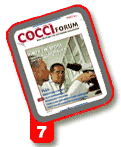COCCI Profile - Coccidiosis Vaccination Takes Hold in China
More producers accepting concept of biological prevention
 Veterinarians, nutritionists and producers in China fill room at recent
meeting to learn more about coccidiosis vaccination.
|
Coccidiosis is one of the most
severe parasitical diseases of
broilers and broiler breeders in
China, often presenting with severe
clinical signs, including red blood in the
feces, poor flock uniformity and mortality.
The costly parasitic infection can
cause subclinical disease, too, characterized
by signs such as poor weight
gain. Subclincal disease is more likely
to occur when other conditions, particularly
necrotic enteritis, are present.
"In the past, we mainly adopted
three methods for control of coccidiosis,"
says Tai Youhua, DVM, director of
the Animal Health Center for Zhucheng
Foreign Trade Broiler Co. Ltd, the second-
largest broiler integrator in China's
Shandong Province.
"First we managed the rearing style,
such as rearing birds on net. Second,
we rotated and shuttled the anticoccidials
in feed. Third, we administered various
anticoccidial medicines, including
diclazuril, or sulfa drugs," he says.
"But none of these methods generated
the same efficacy as they had
before. Due to resistance, in-feed anticoccidials
such as ionophores and synthetic
chemicals are no longer as efficacious
as they once were, and it was
time to adopt a new way of thinking in
coccidiosis control by developing
immunity through vaccination," Tai
adds.
Medication problems
Besides resistance, he says, controlling
coccidiosis with medications raises
another problem: Residues. Sulfa drugs
such as sulfaquinoxaline and sulfadimidine
are highly efficacious in reducing
mortality and controlling symptoms. As
a result, sulfa drugs are frequently the
product of choice in China when coccidiosis
breaks out due to their efficacy
and cheaper price.
"But there are restrictions on sulfa
drug residues in poultry to be exported
to Japan," Tai says. "It is difficult for us
to monitor the choice of anticoccidial
by contract growers, so residues are a
big concern for poultry meat
exporters."
In addition, there are restrictions on
residues in exported broiler meat for
medicines including clopidol and nicarbazine,
which along with sulfaquinoxaline
have been banned by the Ministry
of Agriculture of China. It is likely that
more in-feed anticoccidials will be
banned in the future, he predicts.
The solution: vaccination
Because resistance and residue were
serious concerns for export-oriented
and "green" bird integrators, Zhucheng
started vaccinating day-old chicks with
Coccivac-B, which provides lifelong
protection against four leading species of Eimeria that affect broilers. The birds
are vaccinated in the hatchery with a
specially designed spray cabinet that
provides uniform dosing.
The result, according to Tai, has
been good control of coccidiosis. There
has been a significant reduction in the
need for treatment and subsequent
concern about residues. The vaccine
also has replaced field-resistant oocysts
with highly sensitive vaccine oocysts,
he says.
Vaccinating for coccidiosis, Tai continues,
also provides an excellent
method of avoiding problems with
resistance and residues. The oocyst
species used to produce the vaccine
were isolated before in-feed anticoccidials
on the market were launched
and are therefore highly sensitive to all
approved ionophores and chemical
treatments. That's why replacing resistant
field strains with oocysts in the vaccine
is beneficial, he says.
"Since the end of 2001, we have
vaccinated about 25 million birds with
Coccivac-B," reports Wang Chunming,
chief veterinarian of the Animal Health
Center. "In fact, we mandated that all
birds reared on the floor must be vaccinated
at day of age by Coccivac-B
through spraying in the hatchery.
"Our growers have accepted the
concept of vaccination, especially since
they saw the results obtained with the
first 1.3 million birds either vaccinated
or medicated respectively," he adds.
Those results showed that vaccinated
birds had an equal or better performance
index than non-vaccinated
birds. "As a result, growers no longer
use anticoccidials in feed for prevention
or in drinking water for treatment,
except for the occasional use of
diclazuril to control mild post-vaccination
reactions. We are free of coccidiosis
and residues in broilers," he says.
Technical service crucial
Because biological prevention against
coccidiosis is a new concept for the
broiler industry in China, successful
implementation of coccidiosis vaccination
required good technical service.
According to Tai, Schering-Plough
Animal Health's technical personnel
introduced the advantages of coccidiosis
vaccination and created interest in
Coccivac-B. They defined a trial protocol
based on local conditions with
clients and taking into account the location,
number of birds, groupings and
measurement index. The team of specialists
also provided crucial supportduring the trial, including on-site visits
at 7, 14 and 21 days post-vaccination.
The trial enabled customers to realize
the advantage of Coccivac-B and
helped Schering-Plough Animal Health
learn how to adapt Coccivac-B to local
conditions.
"We have about 2,500 growers,"
adds Wang. "It is very difficult for us to
teach all growers about using Coccivac-
B in a short time."
As a result, Schering-Plough Animal
Health's technical staff in China provided
training to most of the growers,
which are located in 75 villages within
a 200 km radius. In addition, the company
provided a concise and easily
understood post-vaccination management
list, which included information
on feed, litter, moisture, necrotic enteritis
and vaccination reaction control, he
says.
The training, coupled with post-vaccination
on-site visits and management
tips, enabled growers to develop adequate
skills and knowledge about
Coccivac-B. "That eventually solved the
problems of resistance and residues -
both issues that perplexed our business
before," Wang says.
Schering-Plough Animal Health's
technical service specialist David Xuan
agrees, adding, "The success of
Coccivac-B depends on post-vaccination
management, which must be
customized to the local situation.
Coccivac-B can become the best choice
for coccidiosis control if a concrete
and practical technical service plan is
provided."
Source: CocciForum Issue No.7, Schering-Plough Animal Health.







